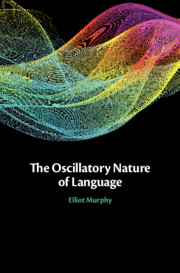Refine search
Actions for selected content:
6584 results in Grammar and Syntax
4 - Conclusions and Future Directions
-
- Book:
- The Oscillatory Nature of Language
- Published online:
- 20 October 2020
- Print publication:
- 05 November 2020, pp 234-245
-
- Chapter
- Export citation
1 - Theory and Praxis
-
- Book:
- The Oscillatory Nature of Language
- Published online:
- 20 October 2020
- Print publication:
- 05 November 2020, pp 16-52
-
- Chapter
- Export citation
Contents
-
- Book:
- The Oscillatory Nature of Language
- Published online:
- 20 October 2020
- Print publication:
- 05 November 2020, pp vii-x
-
- Chapter
- Export citation
Introduction
-
- Book:
- The Oscillatory Nature of Language
- Published online:
- 20 October 2020
- Print publication:
- 05 November 2020, pp 1-15
-
- Chapter
- Export citation
3 - A Neural Code for Language
-
- Book:
- The Oscillatory Nature of Language
- Published online:
- 20 October 2020
- Print publication:
- 05 November 2020, pp 135-233
-
- Chapter
- Export citation
Index
-
- Book:
- The Oscillatory Nature of Language
- Published online:
- 20 October 2020
- Print publication:
- 05 November 2020, pp 319-322
-
- Chapter
- Export citation
Dedication
-
- Book:
- The Oscillatory Nature of Language
- Published online:
- 20 October 2020
- Print publication:
- 05 November 2020, pp v-vi
-
- Chapter
- Export citation
Preface
-
- Book:
- The Oscillatory Nature of Language
- Published online:
- 20 October 2020
- Print publication:
- 05 November 2020, pp xi-xiv
-
- Chapter
- Export citation
Glossary
-
- Book:
- The Oscillatory Nature of Language
- Published online:
- 20 October 2020
- Print publication:
- 05 November 2020, pp 246-248
-
- Chapter
- Export citation
Copyright page
-
- Book:
- The Oscillatory Nature of Language
- Published online:
- 20 October 2020
- Print publication:
- 05 November 2020, pp iv-iv
-
- Chapter
- Export citation

The Oscillatory Nature of Language
-
- Published online:
- 20 October 2020
- Print publication:
- 05 November 2020
References
-
- Book:
- An Introduction to English Sentence Structure
- Published online:
- 24 September 2020
- Print publication:
- 15 October 2020, pp 375-411
-
- Chapter
- Export citation
Glossary and Abbreviations
-
- Book:
- An Introduction to English Sentence Structure
- Published online:
- 24 September 2020
- Print publication:
- 15 October 2020, pp 332-374
-
- Chapter
- Export citation
Preface
-
- Book:
- An Introduction to English Sentence Structure
- Published online:
- 24 September 2020
- Print publication:
- 15 October 2020, pp ix-xi
-
- Chapter
- Export citation
Index
-
- Book:
- An Introduction to English Sentence Structure
- Published online:
- 24 September 2020
- Print publication:
- 15 October 2020, pp 412-422
-
- Chapter
- Export citation
4 - Null Constituents
-
- Book:
- An Introduction to English Sentence Structure
- Published online:
- 24 September 2020
- Print publication:
- 15 October 2020, pp 152-208
-
- Chapter
- Export citation
Dedication
-
- Book:
- An Introduction to English Sentence Structure
- Published online:
- 24 September 2020
- Print publication:
- 15 October 2020, pp v-vi
-
- Chapter
- Export citation
Copyright page
-
- Book:
- An Introduction to English Sentence Structure
- Published online:
- 24 September 2020
- Print publication:
- 15 October 2020, pp iv-iv
-
- Chapter
- Export citation
5 - Head Movement
-
- Book:
- An Introduction to English Sentence Structure
- Published online:
- 24 September 2020
- Print publication:
- 15 October 2020, pp 209-264
-
- Chapter
- Export citation
6 - Phrasal Movement
-
- Book:
- An Introduction to English Sentence Structure
- Published online:
- 24 September 2020
- Print publication:
- 15 October 2020, pp 265-331
-
- Chapter
- Export citation
